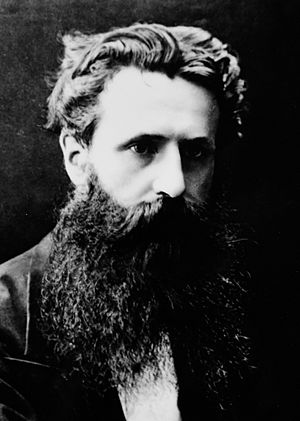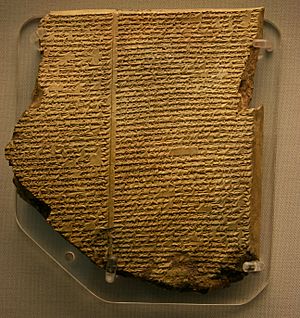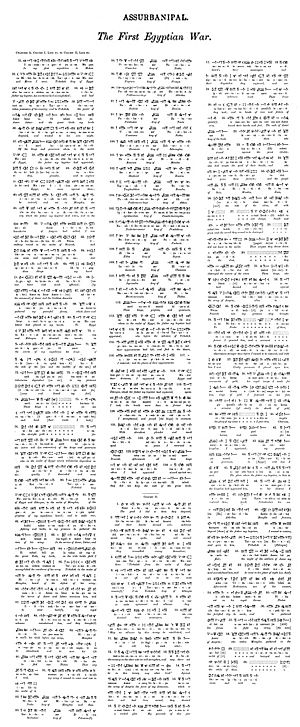George Smith (Assyriologist) facts for kids
Quick facts for kids
George Smith
|
|
|---|---|
 |
|
| Born | 26 March 1840 |
| Died | 19 August 1876 (aged 36) |
| Nationality | British |
| Known for | Discovered and translated the Epic of Gilgamesh |
| Scientific career | |
| Fields | Assyriology |
| Institutions | British Museum |
George Smith (born March 26, 1840 – died August 19, 1876) was a British expert in ancient Assyrian culture. He was the first person to discover and translate the Epic of Gilgamesh. This epic poem is one of the oldest stories ever written.
Contents
Early Life and His Passion for History
George Smith grew up in a working-class family in Victorian England. Because of this, he did not get much formal schooling. At age 14, he started working as an apprentice at a publishing company in London. He became very good at engraving banknotes.
Even from a young age, George was fascinated by ancient Assyrian culture and history. He read every book he could find on the topic. While working, he spent his lunch breaks at the British Museum. There, he studied cuneiform tablets. These tablets were found in modern-day Iraq by explorers like Austen Henry Layard and Henry Rawlinson. In 1863, Smith married Mary Clifton, and they had six children.
Working at the British Museum
George Smith's amazing talent for understanding cuneiform writing was noticed by Samuel Birch. Birch was an Egyptologist and a director at the British Museum. He introduced George to the famous Assyriologist Sir Henry Rawlinson.
By 1861, George was already working evenings at the Museum. He helped sort and clean many fragile clay tablets. In 1866, he made his first important discovery. He found the date when Jehu, a king of Israel, paid a tax to Shalmaneser III. Sir Henry Rawlinson then suggested that George should help him with new volumes of The Cuneiform Inscriptions of Western Asia. In 1870, George Smith became a Senior Assistant in the Assyriology Department.
Amazing Discoveries of Ancient Texts
In early 1867, George Smith made two unique discoveries. The first was about a total eclipse of the sun. This was written on a tablet called K51. He realized it matched a famous eclipse that happened on June 15, 763 BC. This discovery helped historians figure out the timeline of the ancient Near East.
His other discovery was the date of an invasion of Babylonia by the Elamites in 2280 BC. In 1871, Smith published a book called Annals of Assur-bani-pal. He also shared his work on the early history of Babylonia. He also explained his success in reading Cypriot inscriptions.
The Epic of Gilgamesh and Expeditions


In 1872, George Smith became world-famous. He translated a Babylonian story about a Great Flood. He read this story to a group called the Society of Biblical Archaeology. Even the Prime Minister, William Ewart Gladstone, was there.
This story is now known as the eleventh tablet of the Epic of Gilgamesh. It is one of the oldest known works of literature. It was found in 1853 by Hormuzd Rassam. The editor of The Daily Telegraph newspaper, Edwin Arnold, was so excited. He paid for Smith to travel to Nineveh to find more missing pieces of the Flood story. On this trip, George found more tablets and fragments. These fragments helped explain the history of Babylonian rulers.
In November 1873, Smith went back to Nineveh for a second trip. This time, the British Museum paid for his journey. He continued digging at the ancient site of Kouyunjik (Nineveh). He wrote about his work in a book called Assyrian Discoveries, published in 1875. He spent the rest of that year putting together and translating fragments about the creation story. These were published in The Chaldaean Account of Genesis (1880).
Final Journey and Legacy
In March 1876, the British Museum sent George Smith on one more trip. He was to excavate the rest of the Library of Ashurbanipal. Sadly, he became very ill with dysentery in a small village near Aleppo. He passed away in Aleppo on August 19, 1876. He left behind his wife and several children. The Queen granted his family an annual payment of 150 pounds.
George Smith's work was incredibly important. He helped us understand ancient civilizations and their stories, especially the Epic of Gilgamesh.
See also
 In Spanish: George Smith (asiriólogo) para niños
In Spanish: George Smith (asiriólogo) para niños

